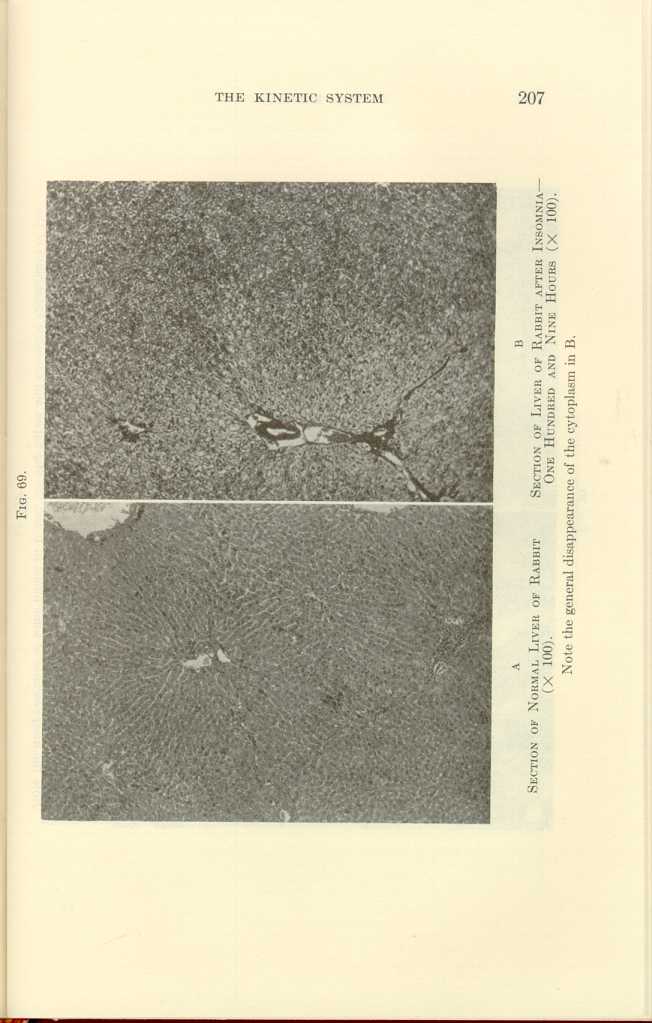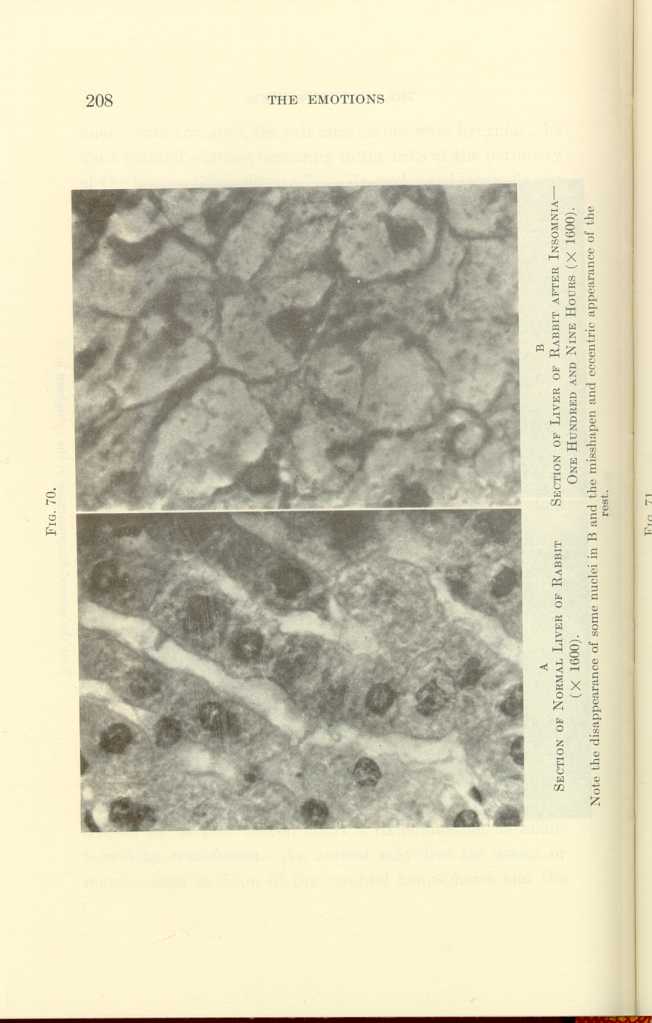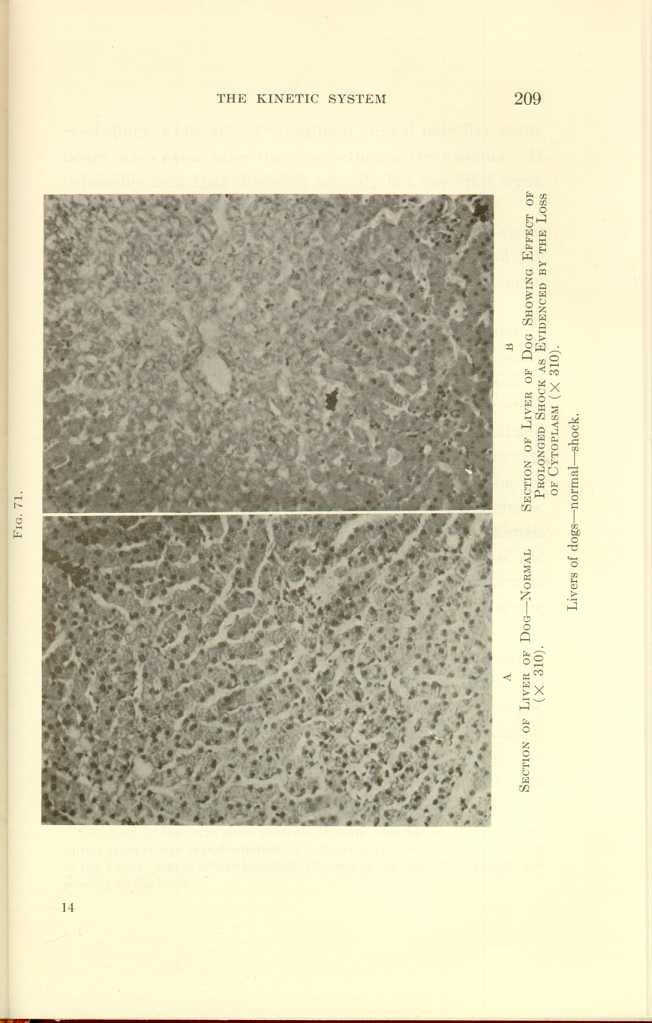| The Origin and Nature of the Emotions: Miscellaneous Papers | ||
The Liver
Prolonged insomnia, prolonged physical exertion, infections, injections of toxins and of strychnin, rage and fear, physical injury under anesthesia, in fact, all the adequate stimuli which affected the brain and the adrenals, produced constant and identical histologic changes in the liver—the cells stained poorly, the cytoplasm was vacuolated, the
Are the histologic changes in the liver cells due to metabolism or toxic products, or are they "work" changes incident to the conversion of latent into kinetic energy? Are the brain, adrenals, and liver interdependent? The following facts establish the answers to these queries:
(1) The duration of life after excision of the liver is about the same as after adrenalectomy—approximately eighteen hours.
(2) The amount of glycogen in the liver was diminished in all the experiments showing brain-adrenal activity; and when the histologic changes were repaired, the normal amount of glycogen was again found.
(3) In crossed circulation experiments changes were found in the liver of the animal whose brain received the stimulus.
From these premises we must consider that the brain, the adrenals, and the liver are mutually dependent on one another for the conversion of latent into kinetic energy. Each is a vital organ, each equally vital. It may be said that excision of the brain may apparently cause death in less time than excision of the liver or adrenals, but this statement must be modified by our definition of death. If all the brain of an animal be removed by decapitation, its body may live on for at least eleven hours if its circulation be maintained by transfusion. An animal may live for weeks or months after excision of the cerebral hemispheres and the

FIG. 69.
A: Section of Normal Liver of Rabbit (x100).
B: Section of Liver of Rabbit after Insomnia—One Hundred and Nine
Hours (x100).[k]
[Description: Black-and-white photograph showing liver of rabbit under
various conditions.]

FIG. 70.
A: Section of Normal Liver of Rabbit (x1600).
B: Section of Liver of Rabbit after Insomnia—One Hundred and Nine
Hours (x1600).[l]
[Description: Black-and-white photograph showing liver of rabbit under
various conditions.]

FIG. 71.
A: Section of Liver of Dog—Normal (x310).
B: Section of Liver of Dog Showing Effect of Prolonged Shock as
Evidenced by the Loss of Cytoplasm (x310).
Liver of dogs—normal—shock.
[Description: Black-and-white photograph showing liver of rabbit under
various conditions.]
In our research to discover whether any other organs should be included with the brain, the adrenals, and the liver in this mutually interdependent relation, we hit upon an experiment which throws light upon this problem.
Groups of rabbits were gently kept awake for one hundred hours by relays of students, an experiment which steadily withdrew energy but caused not the slightest physical or emotional injury to any of them; no drug, toxin, or other agent was given to them; they were given sufficient food and drink. In brief, the internal and external environments of these animals were kept otherwise normal excepting for the gentle stimuli which insured continued wakefulness. This protracted insomnia gradually exhausted the animals completely, some to the point of death even. Some of the survivors were killed immediately after the expiration of one hundred hours of wakefulness, others after varying intervals.
Histologic studies were made of every tissue and organ in the body. Three organs, the brain, the adrenals, and the liver, and these three only, showed histologic changes. In these three organs the histologic changes were marked, and were almost wholly repaired by one séance of sleep. In each instance these histologic changes were identical with those seen after physical exertion, emotions, toxins, etc.[4] It
With these three kinetic organs we may surely associate also the "furnace," the muscles, in which the energy provided by the brain, adrenals, and liver, plus oxygen, is fabricated into heat and motion.
Benedict, in his monumental work on metabolism, has demonstrated that in the normal state, at least, variations in the heart-beat parallel variations in metabolism. He and others have shown also that all the energy of the body, whether evidenced by heat or by motion, is produced in the muscles. In the muscles, then, we find the fourth vital link in the kinetic chain. The muscles move the body, circulate the blood, effect respiration, and govern the body temperature. They are the passive servants of the brain-adrenal-liver syndrome.
Neither the brain, the adrenals, the liver, nor the muscles, however, nor all of these together, have the power to change the rate of the expenditure of energy; to make possible the increased expenditure in adolescence, in pregnancy, in courting, and mating, in infections. No one of these organs, nor all of them together, can act as a pace-maker or sensitizer. The brain acts immediately in response to the stimuli of the moment; the adrenals respond instantly to the fickle brain and the effects of their actions are fleeting; the liver contains fuel only and cannot activate, and the muscles in turn act as the great furnace in which the final transformation into available energy is made.
| The Origin and Nature of the Emotions: Miscellaneous Papers | ||